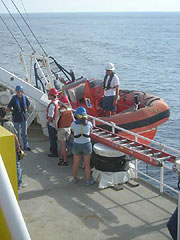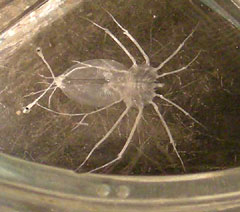

 | |||||||
|
|
Journals 2007/2008Heather Judkins
November 6, 2007 Apparently I thought that yesterday was my only day onboard and I attempted to observe and learn every project that we are doing! As a result, I was exhausted by the time the night activities were through. So for today, I conscientiously made an effort to slow down the pace and I think it worked! Before I hit the hay last night, I witness the dipnetting effort. It looks extremely hard but I will be tackling that later on in the cruise. They caught 4 different types of flyingfish and yep, I have seen my first live Pacific squid! No pictures yet because I was having fun trying to figure out which species it was but I have many more days for them. We also deployed two types of plankton nets for collection and brought them up for analysis. This morning, we woke up and had a small boat safety lesson on the Zodiac procedures. Any time we are on the winch deck or lower, we must wear a hardhat and life vest if operations are going on. The Zodiac is used for chasing any marine mammals that are within range to collect a biopsy for genetic studies on the schools. Today we are in the closing mode for the dolphins which means that if they are spotted, we can follow them until the observers get a positive identification and count of the group size. If the dolphins seem to be coming close to the ship then the word goes out to drop the Zodiac in for biopsies. This has only happened 5 times since August so I have high hopes that November is lucky for us!  After that, I spent the day learning the ropes up on the fly bridge and observation techniques. This morning I saw a large group of spotted dolphins as well as 2 beaked whales! They are larger than dolphins and similar to pilot whales one would see at SeaWorld. I also saw my first Olive Ridley turtle very close to the ship. The following picture is one of the zooplankton samples. The scientists and I have no idea what it is. My zooplankton ID book would have come in handy here! Any ideas?  Marine Science Questions: 1. What phylum is this organism in? How do you know? (see picture) 2. I can tell that it could be a decapod of some sort. Using a plankton field guide, identify it for me and email me what you think. Common name and scientific name would be great! We really have no idea at this point... |
||||||